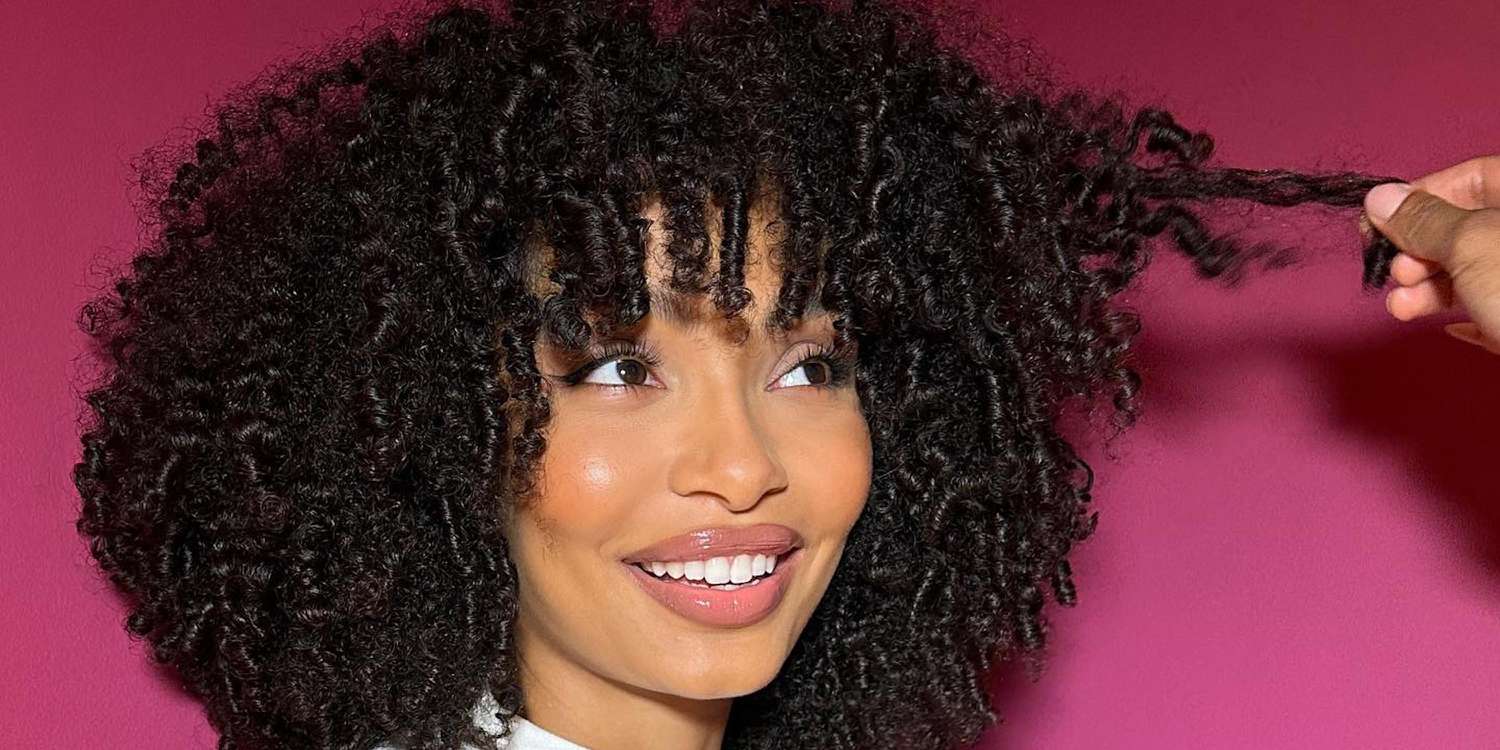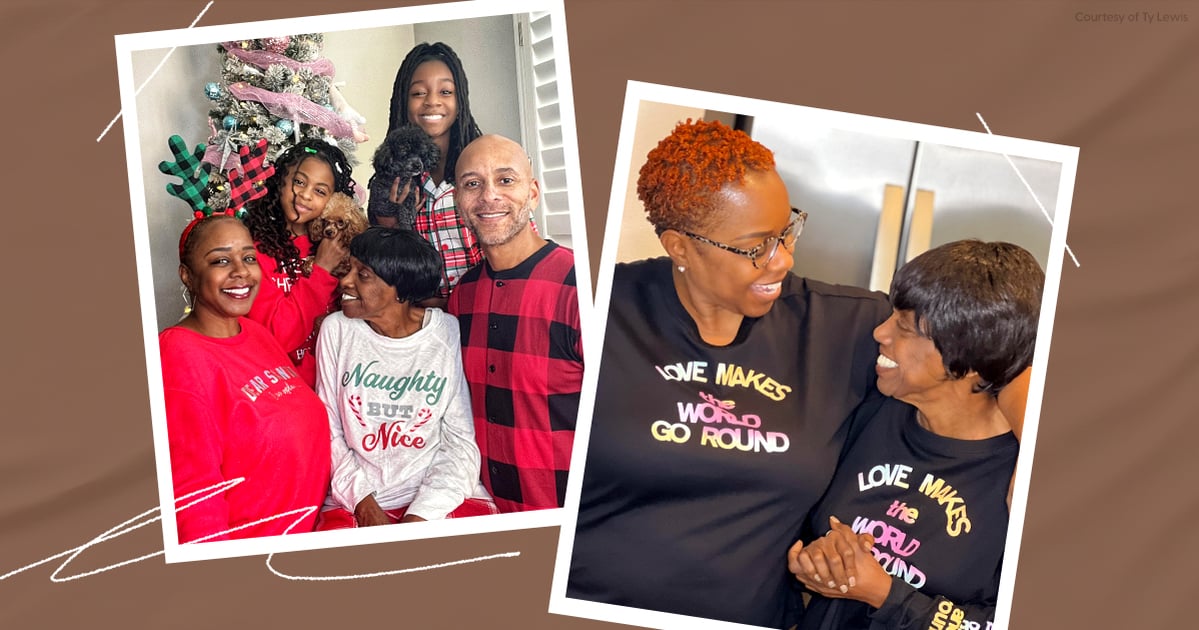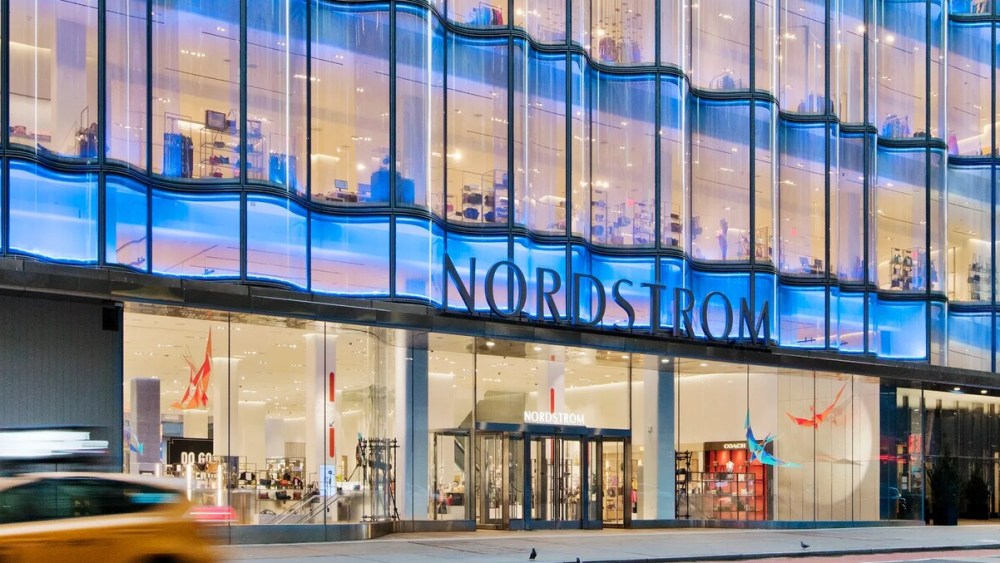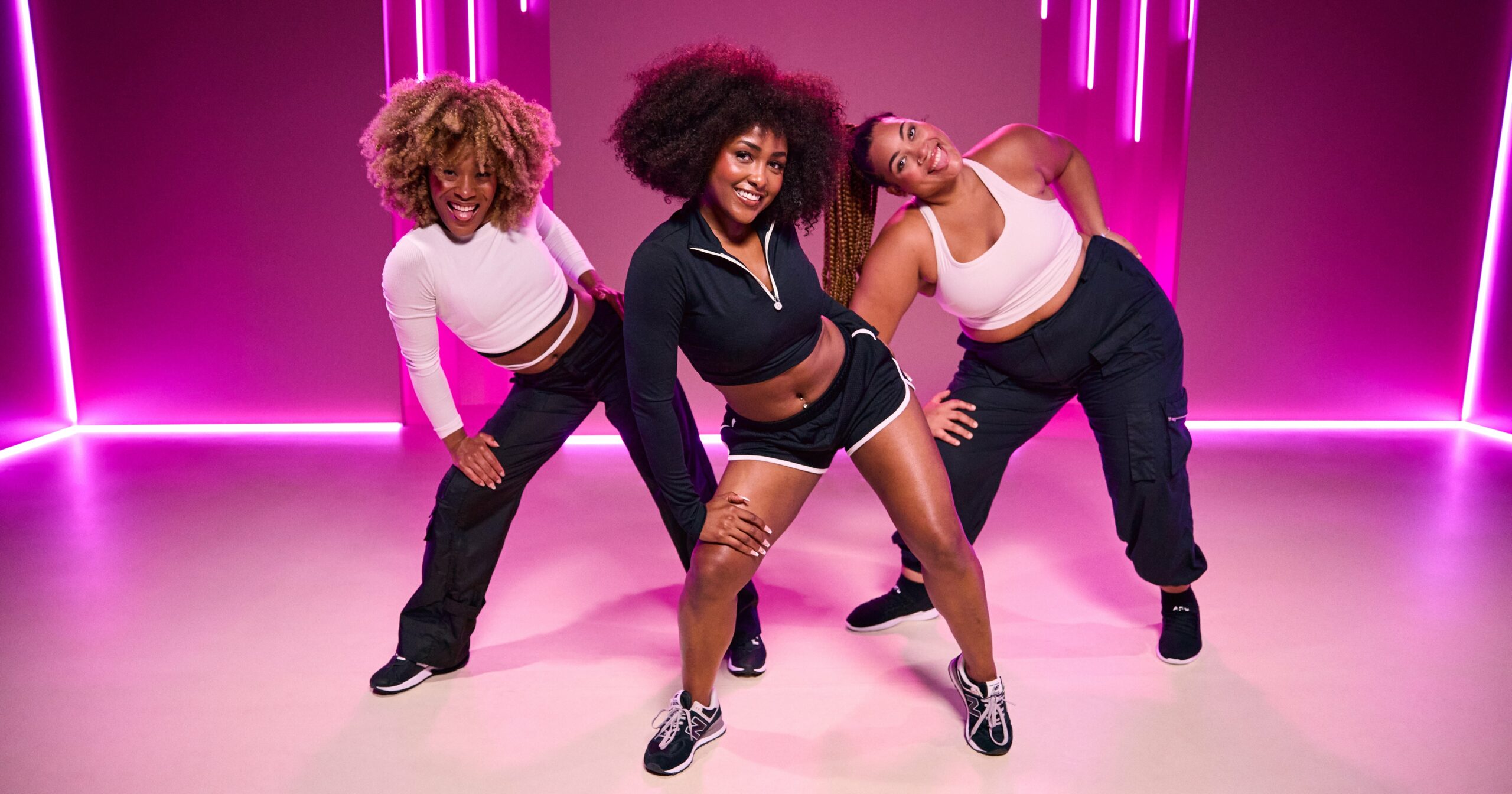Bangs get a bad rap. It’s no surprise given the chop’s known association with heartbreak, but not all bangs are the result of a relationship gone wrong. Regardless of intent, the decision to cut bangs is a serious commitment, and one you don’t want to screw up. When choosing the best bangs for you, you should take the opposite of a one-size-fits-all approach: Consider your face shape, hair type, and desired maintenance level to find your ideal cut (and don’t be afraid to consult a pro). If you’ve fully thought through the implications and are still ready to make the chop, how do you know which bangs are right for you? Ahead, hairstylists share the ultimate guide to 14 different types of bangs, plus how to choose which to get.
Curtain Bangs
Jeff Kravitz/Getty Images
What They Are
“A curtain bang is when the hair is cut slightly shorter in the middle and gradually gets longer as it works towards the outer area of the bang,” explains hairstylist and Schwarzkopf digital artist team member Brendnetta Ashley. “Think of how curtains look when they are open.” According to Pierre Michel Salon style and salon director Jerome Lordet, these longer bangs are roughly chin-length and frame the face with layers. They’re typically worn with hair parted down the middle.
While curtain bangs had a major moment over the past few years thanks to TikTok, stars like Jennifer Lopez, Zooey Deschanel, and Halle Berry have been rocking the style since long before that. As evidenced by the previous list of celebs (and their very different hairstyles and types), curtain bangs can work for almost anyone—hairstylist and makeup artist Mehria Aziz says they simply provide a nice frame around the face.
Curtain bangs are best styled when blown out with a one-inch round brush for added volume. According to Lordet, you can flip them out away from the face to define the bang or flip them inward to blend the bangs into the hair and give the appearance of a face-framing layer.
Who Should Consider Them
While all three experts consider curtain bangs universal, they look particularly good on longer, straight-to-wavy hairstyles. Plus, it’s worth noting that you’ll get the best visual effect with a center part, Ashley says. Curtain bangs can also accentuate layers or longer fringe nicely, Lordet adds, noting that they work particularly well as face-framing pieces when paired with a messy updo. According to Aziz, they’re also great at adding dimension to rounder face shapes.
Who Might Avoid Them
“People with curlier hair will need more styling to get the blended-in, voluminous look that most people associate with curtain bangs,” Lordet shares. And while you can technically achieve curtain bangs on short hair, it doesn’t always work as well as it does with medium to longer lengths. Finally, those with exaggerated side parts may want to avoid the style, given it’s worn best with a middle part.
Side Bangs
@gabunion / Instagram
What They Are
According to Aziz, side bangs are angled bangs that start from a side part and sweep across the face, gradually getting longer. Lordet describes them as a half, shorter curtain bang, sitting just above the chin and generally framing one side of the face.
Though heavily associated with the ’60s and early 2000s, the side-swept style is a versatile classic that still can work today. Side bangs add a softness to the face that’s best styled with a round or paddle brush and a light-hold hairspray like the Schwarzkopf OSiS+ Elastic Finish Hairspray ($14).
Who Should Consider Them
Side bangs look great with bobs and long, layered cuts, as well as with round and square face shapes. That being said, they’re generally considered versatile since versions of them can work for any length, hair type, and texture.
Who Might Avoid Them
Like we said, side bangs are fairly universal, but there are a few things to keep in mind. If you have thinner hair, Ashley suggests avoiding side bangs and opting for something more blunt to add fullness. Also, those committed to a middle part may not be the best candidates for side bangs.
Long Bangs
Danielle Venturelli/Getty Images
What They Are
Long bangs hit anywhere from the brows to the cheekbones or lower, making them a great option for those looking to test bangs out but aren’t fully committed. Ashley says that long bangs provide a classic bangs look, but they can also easily be tucked behind the ear or pulled up into a ponytail, giving wearers a number of styling options.
While styling options are ample, we suggest blow drying them with a round brush to add some volume and texture. For those with curly hair, simply follow your air-dry routine as usual.
Who Should Consider Them
“Longer bangs are great for people with curlier hair,” Lordet shares. “Stylists should cut them dry, and they should be able to air dry and create the desired look.” He also notes that the style works well on those with bigger foreheads, and typically longer faces, since they can achieve the look without hair in their eyes. Meanwhile, Aziz says the style looks best on oval face shapes.
Who Might Avoid Them
People with smaller foreheads may want to avoid long bangs (or ask your stylist about how best to achieve them), as hair is more likely to cover your eyes and make it difficult to see. Lordet and Ashley also suggest that those with rounder faces consider different bangs, as long bangs can emphasize the widest part of the face.
Blunt Bangs
Jon Kopaloff/Getty Images
What They Are
As Aziz explains, blunt bangs are one length straight across the forehead, typically just above the eyebrow. The bluntness results in a thick, full look that the likes of Jessica Biel, Kerry Washington, and Rashida Jones have rocked expertly. Blunt bangs are cut thicker than traditional fringe or curtain bangs, and they don’t allow for much movement, making the cut quite a commitment in terms of styling.
“Since blunt bangs are the main character of the style, you want them to stand out,” Ashley says. “They are the focal point of the haircut.” To style, she suggests using a Denman-style brush with longer, strong nylon bristles while blow drying the bangs downward. And be sure to start with the bangs first—”The key is to get this area under control while it’s still damp,” she shares.
Who Should Consider Them
We’ll be, well, blunt: Not everyone can rock blunt bangs. Aziz says they look best on oblong face shapes, while Ashley says they pair well with blunt bobs and ultra-long hair. Full, fluffy blunt bangs are also a great way to beef up finer hair.
Who Might Avoid Them
Blunt bangs might not be the best choice for those with square face shapes unless you’re looking to emphasize your strong angular features. Per Lordet, blunt bangs require a good amount of styling, so those who prefer a low-maintenance hair routine will probably find the look cumbersome. Finally, Ashley says those with cowlicks should avoid blunt bangs, as it will take a lot of effort to keep the style in peak form.
Curly Bangs
Todd Owyoung/Getty Images
What They Are
If you’re looking to add some shape to your curly hair, consider rocking a set of curly bangs. The beauty of the curly bang is its versatility: “A curly bang can be centered or side-parted, and can also be long or short,” Ashley shares. “Regardless of your face shape, if you have curly hair you should try a curly bang.”
Not only are they a great way to explore a new style, but curly bangs are also ideal for playing up natural texture. Shrinkage is real when it comes to curly hair, so our experts all suggest having your stylist cut your curly bangs on dry hair—that way, they won’t accidentally end up too short.
Who Should Consider Them
Curly bangs can be worn long or short, centered or parted to the side, and so on—basically, regardless of your face shape, you can rock a curly bang. The only real requirement is that your hair is, in fact, curly.
Who Might Avoid Them
Like we said, as long as your hair is curly, you can (and should!) try curly bangs. Just make sure you discuss your desired result and maintenance level with your stylist, so you can end up with a version that works well for you.
Wispy Bangs
Neilson Barnard/Getty Images
What They Are
Wispy bangs are thin and piece-y—think softer, feathered bangs with the tiniest bit of weight at the ends. Often cut with a feather razor, these light, airy bangs frame the face and add a general sense of softness to a cut. They’re also super easy to style, and they work on a wide range of hair types and face shapes. According to Ashley, wispy bangs are a great style to try for those considering bangs for the first time—they’re easily manageable and customizable to best suit your needs.
Regularly seen on mega-celebs like Dakota Johnson, Alexa Chung, and Elizabeth Olsen, there’s no denying the cool-girl factor that comes with a great set of wispy bangs. Best of all, they’re fairly easy to style—simply blow dry or let them air dry as preferred.
Who Should Consider Them
Because they can be tweaked to fit different face shapes and hair types, Lordet says wispy bangs work well on most people. Ashley agrees, though she notes the style looks particularly great on straight to wavy hair. Meanwhile, Aziz is a fan of the bangs on square and heart-shaped faces.
Who Might Avoid Them
There are few hair styles that can’t rock a great set of wispy bangs. That being said, Lordet does note that it can be more difficult to achieve the look on thicker hair, so talk to your stylist about the best way to achieve your desired result if this is you.
Choppy Bangs
Ernesto S. Ruscio/Getty Images
What They Are
A choppy bang is cut straight across with heavily designed texture. This gives the style a more high-fashion feel. According to Ashley and Aziz, choppy bangs are similar to blunt bangs—just more texturized. With softly broken ends and a piece-y feel, they add a sense of edginess to any style without making an overwhelming statement.
You can also add a bit of choppiness to any existing type of bang you have—from wispy to micro. To style, our experts suggest using a flat iron to slightly curl the ends of the fringe to really play up that texture.
Who Should Consider Them
Because you can make any style into choppy bangs, they tend to work on a wide variety of face shapes and hairstyles. That being said, Ashley shares that this style looks particularly good when paired with a mid-length layered cut. And like blunt bangs, choppy bangs look great on more oblong face shapes too, according to Aziz.
Who Might Avoid Them
Wispy bangs can work on virtually all face shapes and hair types, so they’re definitely worth giving a try—just talk to your stylist first if you’re not sure what shape will work best for you.
Layered Bangs
Axelle/Bauer-Griffin/Getty Images
What They Are
Layered bangs are exactly what they sound like: bangs with layers. The less-committal style blends into your hair and features several different lengths—or layers—that add texture and volume to the bangs.
While typically pushed behind the ear, layered bangs can be styled however you please—parted down the middle, laid straight, or with a deep side part. While you can style them a plethora of ways, Ashley suggests blowing these bangs out with a round brush to emphasize volume.
Who Should Consider Them
According to Aziz, layered bangs are ideal for those with flatter hair, as they’ll help give more volume and texture. If you have long, thick strands that are always getting weighed down, this style may be your answer to achieving additional movement.
Who Might Avoid Them
If you have finer hair, Ashley suggests avoiding layered bangs, which don’t offer as much support as an alternative like wispy bangs.
Baby Bangs
Jason LaVeris/Getty Images
What They Are
Baby bangs are short, straight-across bangs that sit between the hairline and brow area. According to Ashley, they’re possible to cut blunt or wispy, but either way, they tend to pack quite the punch.
“Baby bangs can look very harsh, and they can alter face shape more than long bangs, so that should be kept in mind when cutting them,” Lordet warns. Still, the style is seriously chic and can be styled, and even super-stylized, to work on many different hair types.
To style, Ashley suggests smoothing baby bangs out with a flat iron, adding a little twist out at the end for movement.
Who Should Consider Them
Baby bangs are pretty drastic as far as bangs go, so they don’t always work on all hair types and face shapes. Ashley says they look great with a pixie cut, while Aziz says they’re typically most ideal for those with oval or round face shapes.
Who Might Avoid Them
It can be difficult for those with ultra-thick hair to achieve baby bangs, since hair would need quite a bit of thinning in order for the bangs to lay flat. Baby bangs can also be quite finicky when paired with heart-shaped faces, since they emphasize facial angles and give this face shape an even sharper look.
Micro Bangs
Momodu Mansaray/Getty Images
What They Are
Think of micro bangs as baby baby bangs, falling even closer to the hairline. These ultra-short bangs reach around one to two inches down the forehead, according to Aziz, and they make a bold, edgy statement.
To style, Ashley suggests smoothing micro bangs down with a paddle brush and finishing with an anti-frizz cream to give medium hold and shine. She’s a fan of the Schwarzkopf OSiS+ Tame Wild Cream ($20).
Who Should Consider Them
We’ll be honest: Micro bangs can be tough to pull off. That being said, they tend to work best on oval face shapes, especially those with straight hair. Aziz says that round faces can also rock baby bangs.
Who Might Avoid Them
Like with baby bangs, micro bangs can be difficult to achieve on thick hair, as well as very curly hair— the bangs won’t be able to sit flat, and you’ll lose much of the intended shape. If you have one of these hair types but are dead set on a baby or micro bangs look, work with your stylist on how best to adapt them to your style and routine.
Feathered Bangs
Frazer Harrison/Getty Images
What They Are
Feathered bangs are subtly layered with volume as well as ends flipped out. They tend to be medium to long in length and work well worn straight across the face, as well as with a middle or side part—basically, they’re incredibly versatile. Feathered bangs tend to be softer than more traditional variations, with a little bit of weight at the ends.
Who Should Consider Them
Feathered bangs work well on most hair types and face shapes, though Aziz says they’re especially great on square and heart-shaped faces, since they add a bit of softness.
Who Might Avoid Them
The only concern when it comes to feathered bangs is when they’re paired with curly hair. The curls make it difficult to achieve the intended feathered effect and cause them to feel a bit shapeless, so consult with your stylist about ways to achieve the desired shape and movement in a way that works for your curly texture.
Shaggy Bangs
Amy Sussman/Getty Images
What They Are
As Aziz explains it, shaggy bangs are shorter in the center and graduate to longer lengths at the edges. They’re similar to curtain bangs, but they have less of a continuous curve and are more piece-y. They also blend in with the rest of the haircut more, softly disappearing into the rest of the hair.
Shaggy bangs have a distinctly rock-and-roll vibe to them—think choppy lengths, feathery pieces, and wispy fringe. To style, Ashley suggests blow drying your bangs with a round brush to create volume and finishing with a curling iron to give them a slight twist.
Who Should Consider Them
Shaggy bangs work with most hair types and face shapes, though Ashley notes they’re especially stellar alongside a medium shag cut—a style that has variations that work well for various hair types and textures.
Who Might Avoid Them
The only real concern when it comes to getting a shag is if you’re not a fan of having hair in your face. Otherwise, the style works on most people, so go for it!
Bottleneck Bangs
Matt Sayles/Getty Images
What They Are
A combination of traditional fringe and curtain bangs, bottleneck bangs are typically cut long and wispy, Lordet shares. As opposed to curtain bangs that sweep away from the face, bottleneck bangs fall forward to frame the face—think classic Brigitte Bardot hair, with those swoopy, front-facing bangs.
While the style looks best blown out and voluminous, Lordet makes a point of noting that it may require some extra styling time and effort to get that perfectly imperfect look that people tend to want with bottleneck bangs. He also notes that a salt spray can be useful to help achieve texture and volume on those with thinner or straighter hair.
Who Should Consider Them
Bottleneck bangs look best with long, straight, or wavy hair. It’s also a great option for those who already have curtain bangs but are looking to switch things up. While the bangs can work on curly hair, Lordet says it will create a slightly different effect, so keep that in mind. As far as face shapes go, Aziz says the style works best with oval faces.
Who Might Avoid Them
Those who prefer their hair kept out of their face may want to avoid this style, Ashley shares. Meanwhile, Lordet says shorter styles don’t work as well with bottleneck bangs.
Braided Bangs
John Phillips/Getty Images
What They Are
Braided bangs are just that—bangs that are, well, braided. They’re a great option for those who want bangs while wearing a protective hairstyle. They frame the face and can be worn either forward or with a side part.
Who Should Consider Them
Braided bangs are a great option for those with braided hair—duh. Next time you get your hair braided, tell your stylist you’re interested in a look with bangs, and feel free to bring inspiration photos (we love the one on FKA Twigs above!) to ensure you get the result you want.
Who Might Avoid Them
Obviously, if your hair isn’t braided, we suggest trying a different type of bangs.



